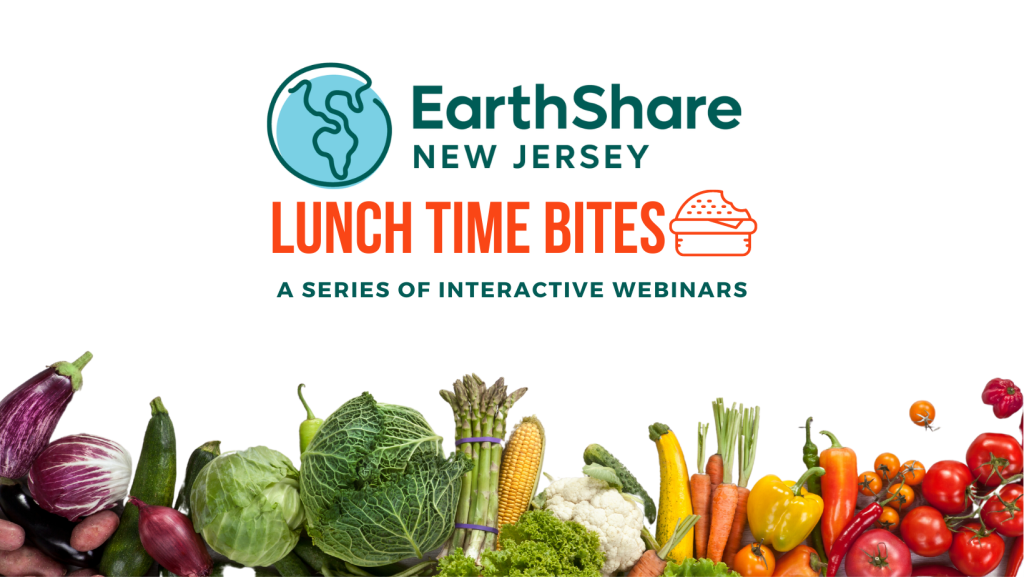
Lunch Time Bites are virtual experiences that engage your employees and support a commitment to the environment. This is a new program from EarthShare New Jersey with exclusive content from our members. The topics range from educational messages about the environment to ways for employees to easily adapt green habits into their lives. These experiences are designed to be educational and interactive with demonstrations, live exhibits, guided walks, and more!
How does it work?
The series of webinars are created directly for corporations and their employees. These webinars will be live with Q&A or a mix of live and prerecorded content. The speakers all represent EarthShare New Jersey members who are experts on their topics of choice. The presentations will be 30 minutes with additional time for introduction and Q&A. Lunch Time Bites webinars can be single or bundled experiences and customized to be presented on the virtual platform your company prefers.
Benefits of this Program:
Testimonials:
“This was such a cool and fun event . Absolutely loved it and learned so much!” – Anonymous TIAA Employee
“I thought this would be a great event for my kids…little did I know how much I love turtles! Turtle Power!” – Anonymous TIAA Employee, Traveling Turtles Presentation
Lunch Time Bites Presentations:




|
Presentations |
|
A Virtual Tour of the Hackensack River |
|
| Using PowerPoint/screen sharing, this photo-heavy presentation takes participants on a 50-mile journey from the headwaters of the river to Port Elizabeth on Newark Bay. We explore the natural and human history of the river, its watershed and its Waterkeeper. Special emphasis is given to the unique urban wilderness that is the Meadowlands | |
Bald Eagles: An All-American Recovery |
|
| The bald eagle population in New Jersey continues to soar largely due to the work of faithful volunteers and biologists. Learn how the population rebound from one pair in the 1980’s to over 260 active pairs today and what is being done to continue monitoring and protecting New Jersey’s eagles. | |
Barnegat Light Habitat Restoration for Beach Nesting Birds |
|
| Learn about efforts to restore breeding habitat for piping plovers and other endangered shorebirds in the shadow of New Jersey’s iconic Barnegat Light. The project, which has become a model for habitat restoration, was completed in 2020 and continues to reap benefits for beach nesting birds. Also, will touch on the status of beach nesting birds in the state and region. | |
Beach Nesting Birds: The Birds of Summer |
|
| Beach nesting birds, including piping plovers, least terns, and black skimmers are some of the most at-risk species in our state. These birds nesting on New Jersey’s busy beaches would likely not survive without intensive monitoring and management. We will discuss efforts to protect these birds, how they are faring, and what you can do to help. | |
Better Backyards: Conserving Water at Home |
|
| There are so many ways that we can be more water efficient in our homes, in the backyard, at school, and at work. Learn how to perform a basic water audit to identify areas for improvement, gardening, and yard tips, what to look for in new appliances, and rainwater harvesting. | |
Creating a Fishable, Swimmable Delaware River |
|
| Developing a “roadmap to clean water” on the Delaware River, supporting the search for justice, jobs and clean water. | |
Creating Community Spaces with Habitat Restoration |
|
| Find out at about a project in the township of Hopewell, New Jersey (Cumberland County) that created a budding centrally located park and habitat for pollinators and grassland birds. | |
Creature of the Night: Bats of NJ |
|
| Our bat program “Creatures of the Night: the Bats of NJ” goes over general bat facts, benefits of bats, common myths & misconceptions, threats bats face, and our bat projects. Bats often get a bad reputation of being spooky or even fearsome, but they are actually some of the most beneficial animals to people, and right now, bats need our help! Join us in a presentation to learn about these amazing night flying creatures in your area, and what you can do to keep them around! | |
Critters, Creeks and Coasts |
|
| From freshwater streams to the beaches of the Delaware Bay, South Jersey is a region of unique habitats and biodiversity. Explore the incredible creatures that can be found at the bottom of a stream, under the leaves of a milkweed plant, or in-between the crevices of an oyster reef. Learn how we work to create and restore habitat for native wildlife and how you can get involved. | |
Eastern Tiger Salamanders |
|
| The Eastern Tiger Salamander is a NJ state endangered species and only found in the southern most part of New Jersey along the coastal plain. Even though most people will never see an ETS in the wild, they are a species we should all care about protecting. They and other amphibians are an indicator species to the health of the environment and water quality. It’s awesome to know that these beautiful and secretive creatures still live in the wild in our state. Learn more about their lifecycle and what is being done to manage and protect these salamanders. | |
Endangered Species of New Jersey |
|
| Join us for a brief bite into the many endangered plants and animals struggling to survive in New Jersey and learn how you can help. Share your lunchtime with a few of our resident endangered animals. | |
Exploring Climate Change through Leave No Trace (LNT) |
|
| Leave No Trace (LNT) is a framework for responsible use and stewardship of natural areas. While our actions often have some degree of local or global impact, we can be aware of and attempt to minimize such impacts to protect and preserve resources for others to enjoy. Through a focus on Leave No Trace, workshop participants will explore how these principles can guide ethical and practical solutions for enjoying the outdoors, in one’s daily life, and in a climate-concerned world. | |
Fish Tagging Program |
|
| Learn about the history of the Fish Tagging Program and find out what we’re doing more than 50 years later to help improve the health of our global fisheries. Find out how and why our anglers tag fish and what we do with the data. | |
Flirting at Flat Rock |
|
| Join us for a look at the world of animal flirting. Dally with the science behind nature’s courtships. Meet a live animal during this program. | |
Gardening for Joy: An Introduction to Native Plant Gardening |
|
| Explore the benefits of gardening for the mind, body, and planet Earth! Learn how planting a garden or any green space at home can create habitat, conserve water, and provide health and wellness benefits all year round. Learn how to incorporate NJ native plants that will be low maintenance, require less water, and support pollinators and other wildlife. We’ll also hear about rain gardens and how they can be installed in your yard to help control flooding and filter stormwater runoff before it enters your streams and ground water. | |
GoTrenton! |
|
| Transportation is one of the largest sources of Greenhouse Gas (GHG) emissions in the state. Over the past few years, we have worked on an EV pilot called GOTrenton! that will help to provide affordable and reliable EV transportation to residents in order to improve mobility and increase access to jobs, healthcare, and new opportunities. This EV Pilot will work to address public health challenges by reducing greenhouse gases and air pollution. | |
Horseshoe Island: Beach Nesting Birds |
|
| Horseshoe Island – A New Island for Birds Emerges Along the New Jersey Coast In a state where undisturbed habitat for our at-risk wildlife is hard to find, a new island that recently formed off New Jersey’s coast provides a haven for nesting and migratory shorebirds. We will share the story of the formation of the island, how various bird species have used this new site, and what is being done to protect the species when they are there. We will also touch on the status of beach nesting birds in the state and region. | |
Interrupting Moonlight Mating for Science |
|
| Every May and June, millions of unassuming Atlantic horseshoe crabs, driven by eons of evolution, make their way to the sandy beaches of the Delaware Bay to spawn. As the nighttime tide comes in, beaches along the bay come alive with amorous horseshoe crabs looking for a chance to reproduce. It is during these annual “lovemaking” events that we get a chance to monitor this unique keystone species. We spend many moonlit nights each year counting and tagging horseshoe crabs with the help of some very motivated volunteers. Over the last ten years, we have brought hundreds of volunteers out to the bay to count and tag thousands of horseshoe crabs. Our volunteer horseshoe crab tagging program helps us to better understand beach use by crabs, educate the public, and, hopefully, grow the ranks of an unofficial horseshoe crab fan club. | |
Introduction to Teaneck Creek |
|
| Welcome to Teaneck Creek Conservancy, a 46 acre eco-art passive trail forested wetland habitat in the heart of Bergen County. Learn more about our unique park and mission. | |
Isles’ CEET: Center for Energy and Environmental Training |
|
| CEET training is part of Isles’ integrated and comprehensive approach to achieving lead safe, green and healthy housing for everyone in NJ. To do this we engage in activities that can make the most difference –including training community members and contractors, making homes lead safe and healthy, advocating to change policy and regulations; and educating the public. Isles believes that by providing access to training and employment in the energy efficiency and health fields we can help create jobs, save energy, prevent abandonment and bring other benefits at a relatively low cost. | |
Isles’ Community Gardens |
|
| Isles’ urban agriculture work addresses hunger, food access, and community disinvestment in Trenton by sharing tools, networks, and resources that empower residents and stakeholders to take action and make healthy choices. We support over 70 community and school gardens by providing technical assistance to local residents, teachers and students, and community-based organizations. We also offer garden-based environmental education to schools and summer programs. Direct beneficiaries of this work include more than 200 community gardeners and family members, 45 teachers, and 1,100 students. | |
Late nights, Living Fossils and Lots of Eggs: A look into Horseshoe Crabs |
|
| Let’s explore the life history, anatomy, and ecological importance of horseshoe crabs. We will then discuss what we do to monitor horseshoe crabs, such as tagging | |
Monitoring American Oystercatchers on the Delaware Bay |
|
| Breeding populations of American oystercatchers have been heavily monitored on New Jersey’s ocean beaches since 2003, but little is known about the oystercatchers nesting along the state’s Delaware Bay beaches…until now. Learn how biologists are working together on a new project to unravel the mysteries of this previously understudied population. Wewill share stories from the field and discuss how on-the-ground monitoring, trail cameras, and bird banding are all being used to learn more about the oystercatchers that call the Delaware Bayshore home. | |
| |
Native vs. Invasive Plants |
| An introduction to common invasive plants and native plant alternatives for backyard habitats & why caring about where plants come from matters. | |
Natural Climate Solutions |
|
| There is a growing sense of urgency that we must work on climate change and impact on multiple levels. Minimizing greenhouse gas emissions, investing in alternative and renewable energy economies, and household efficiencies are important. At the same time, protection and stewardship of natural landscapes also offers multiple benefits. Natural climate solutions offer immediate and cost-effective ways to address the climate crisis. Natural climate solutions include habitat restoration, wetland protection, supporting natural landscapes, agricultural practices, and land conservation. Participants will explore principles and primary examples of natural climate solutions and how these can connect to examples in our communities, neighborhoods, and schoolyards. | |
New Jersey’s Fish Hawk: The Amazing Osprey |
|
| Did you know that in 1974 only 50 osprey nests were left in NJ? Today, ospreys are a common sight along the New Jersey shore during the summer. Join us to learn about the amazing life history of ospreys, current monitoring techniques, and their amazing comeback. We will share this experience from working to manage this amazing species over the past 15+ years. | |
New Jersey’s Rarest Reptiles and Amphibians |
|
| In this talk, a New Jersey biologist will present some of the rarest reptile and amphibian species in the state. Learn about the at-risk species in your area and why they are vital to maintain a balanced ecosystem. We will discuss the threats to these species and how we are working to protect these important and often misunderstood creatures. | |
Owls of New Jersey |
|
| Join us for a look at the amazing world of New Jersey’s owl population. Meet a live owl resident and have a hoot with your lunch! | |
Peregrine Falcons: Flying High in New Jersey |
|
| Peregrine falcons are well known for their beautiful plumage and swift dives to catch prey. Many are not aware that they were once extirpated from New Jersey and critically endangered throughout the United States. They were one of several top tier predatory birds who were devastated from the effects of DDT. To help them recover, they were federally listed as endangered in 1970 and biologists began an innovative program to bring them back. Thanks to the efforts of these biologists, New Jersey is now home to around 40 nesting pairs of peregrines, who nest on the cliffs of the Palisades, buildings and bridges in cities, and former “hacking” towers. They are a symbol of America’s recovering rare species. | |
Plant Power ” A Who’s who of native and invasive plants in your backyard” |
|
| An interactive presentation where participants will learn about the historic uses of plants for food, medicine, and industry, and the effects invasive plants have on native habitats and how you can help. | |
Preserving Public Access to the Coast |
|
| Protecting the public trust doctrine and the public’s right of access to beaches and tidal waters in New Jersey. | |
Rain Gardens, Can you Dig it? |
|
| Rain gardens are a nature-based solution to localized flooding, nonpoint source pollution, and stream bank erosion. Learn how you can use your own back yard to support local ecosystems and water quality in your neighborhood. | |
Remarkable Rocks! |
|
| Join us for a rock-solid foundation in geology. Learn about the three main categories of rocks and what makes them special during this gem of a lunchtime chat! | |
Restoring Wreck Pond Inlet |
|
| Learn about a project designed to mitigate flooding, improve water quality, and facilitate better access into and out of Wreck Pond for fishes that are of special concern in NJ. | |
Sea Creatures with Amazing Features |
|
| Let us share our little animals with you! Participants will use all of their senses and their imagination to discover the wet world of water animals. Following a fun and interactive explanation of the local sea animals, participants will get some quality virtual time with them. Habitats, food chains, and anatomy are some of the topics covered. Animals may include sea stars, sea urchins, hermit crabs, spider crabs, clams, sea snails, and a horseshoe crab. | |
Small, Secretive and Endangered: Bog Turtles |
|
| Did you know that the New Jersey state reptile is the bog turtle? Once abundant throughout New Jersey, bog turtles are now primarily found in the remaining rural areas of New Jersey, such as Sussex, Warren, and Salem counties. Intense land uses such as large-scale agriculture, urbanization, wetland alterations and stormwater outputs are incompatible with bog turtles and have depleted bog turtle populations from much of the state. Since the 1970s biologists have studied the life history, habitats and distribution of the bog turtle in New Jersey. Current conservation efforts are productive and include habitat management, population monitoring, land acquisition and landowner education. The bog turtle was listed as an endangered species in New Jersey in 1974 and as a “threatened” species throughout the United States in 1997. | |
Terrapins and Tires: Community Based Conservation of Terrapins |
|
| Northern diamondback terrapins are a unique, coast hugging turtle that lives exclusively in brackish water. Each year, females exit the protection of their aquatic habitat to seek out suitable areas to lay eggs and help ensure their species lives on. Since 2010, CWF has been engaged in the conservation of terrapins within Barnegat and Great Bay watersheds by recruiting volunteers to help conduct surveys and patrols to reduce road kills of adult females. Join CWF Senior Wildlife Biologist, Ben Wurst as he discusses the amazing life history of terrapins and conservation efforts to help ensure the survival of this species in a changing world. | |
The Importance of Dunes to Coastal Ecology and Community Resilience |
|
| Join us for a presentation focused on coastal ecology. We will discuss the important role dunes play along our coast, a very impactful species of beach grass and how to better protect your shore-based towns. | |
The Incredible Journey of the Piping Plover |
|
| Join us to explore the life and behavior of the piping plover, an endangered shorebird. We will discuss ongoing protection and breeding trends on the beaches of New Jersey, including new developments. We will also draw on personal experiences and survey efforts in the Bahamas, where the largest concentration of piping plovers overwinters. | |
The Story of Salamanders |
|
| Unlike frogs, their boisterous amphibian counterparts, salamanders are generally shy and elusive creatures. In fact, outside of captive specimens held in zoos or aquariums, many people may have never met one face to face. Yet New Jersey is home to 16 species of these amazing animals, all waiting patiently for seasonal rains to announce the onset of the breeding period. During this talk, you’ll learn about the life cycle and adaptations that make salamanders special, and simultaneously weirder and more impressive than the legends that gained them global notoriety promised. Through species profiles, you’ll be introduced to salamander diversity across the Garden State with a special focus on two species that biologists have been working diligently with for over a decade. Finally, we’ll discuss threats that amphibians face and how you can help protect your new favorite neighbors right at home. | |
Thinking Outside the Box about Your Woods and Bogs: How Private Forestry Practices Can Protect Rare Turtles |
|
| Turtles are well-known for their longevity. The oldest member of this group (a Seychelles giant tortoise named Jonathan) celebrated his 191st birthday earlier this year. While a long lifespan is certainly a credit, it also lends a false sense of security when it comes to the stability of a species. High density does not equal “healthy” if young individuals are not rejuvenating a population. New Jersey has been proactive in protecting native turtles through state law, but since much of the remaining habitat available for our rarest species occurs on private property, landowner collaboration is essential for their continued survival. During this talk, we will introduce you to three of our local turtles (box, wood, and bog), discuss management strategies that you can employ in your forests and wetlands to benefit them, and share resources that provide financial and technical support to turtle champions. | |
Traveling Turtles |
|
| These ravishing reptiles elicit awe from people of all age levels. Participants will get a chance to meet a variety of turtles that are native to New Jersey, as well as explore various hands-on turtle artifacts. Your group will dive into topics such as: turtle anatomy, natural history, behaviors, adaptations, life cycles, and more. Participants will also learn about our Diamondback Terrapin Conservation Project and get some quality virtual screen time with live adult terrapins and even some hatchlings. | |
Welcome to New Jersey’s Largest Lake |
|
| The Lake Hopatcong Foundation dedicates itself to protecting the lake environment and enhancing the lake experience, bringing together public and private resources to encourage a culture of sustainability and stewardship on and around New Jersey’s largest lake, for this and future generations. | |
What is Habitat Restoration? |
|
| Capt. Al will discuss what habitat restoration is, why the Society does it, and why it is important. He will also provide some case studies to include restoration in Delaware Bay, Barnegat Bay, and Monmouth County. | |
What the Shell? Mullusks of the Jersey Shore |
|
| Do you ever wonder what the shells are that you see lying in the sand at the beach? There were once creatures inhabiting those shells, known as mollusks. Join us for a presentation all about the shells you can find along the New Jersey shore. We will talk about bivalves, univalves, their life cycles, why they are important to our environment, and much more! | |
Winter Waterfowl and Seals |
|
| Join us for a presentation all about our local winter waterfowl and seal friends. We will look at the different species, characteristics of them, where to spot them and identifying features. We will also go over where we typically look for these species around sandy hook when we have our walks in person. | |
Zero Waste Workshop |
|
| Join us for a webinar that will cover ways to lessen your waste. In this workshop we will go over pollution facts, easy switches, how to complete a trash audit, microfibers, fast fashion, and more. |